Debunking Wheel Stiffness
Are your wheels stiff enough? Do your manly legs pump out so many kilowatts that you flex them like soggy noodles? Stiffness is like training volume, right? More is always better?
I’d like to start this discussion with a very simple question: What IS wheel stiffness? Do you know? If anyone out there can accurately describe it in one paragraph or less, you get a gold star. I don’t even think I could do it, which is why we’re dedicating an entire article to it.
The biggest problem with the wheel stiffness discussion is that the term is thrown around far too much and without nearly enough context. What kind of stiffness are you talking about – in what plane? What part of the wheel is too stiff (or not stiff enough) – the spokes, the rim, or the hub? And what design attribute of that particular part is causing the issue?
Without getting too far ahead of ourselves, I hope it’s evident that there’s a lot going on here. Let’s dive in and dissect the mystery.
Types of Wheel Stiffness
We’ll begin with the basics. There are three planes of stiffness that we’re concerned about with wheels: Torsional, Radial, and Lateral.
Torsional stiffness is concerned with the ‘twisting’ of a wheel – for example, when you accelerate hard in a sprint (thanks to our friends at Mavic for lending the following few graphics):
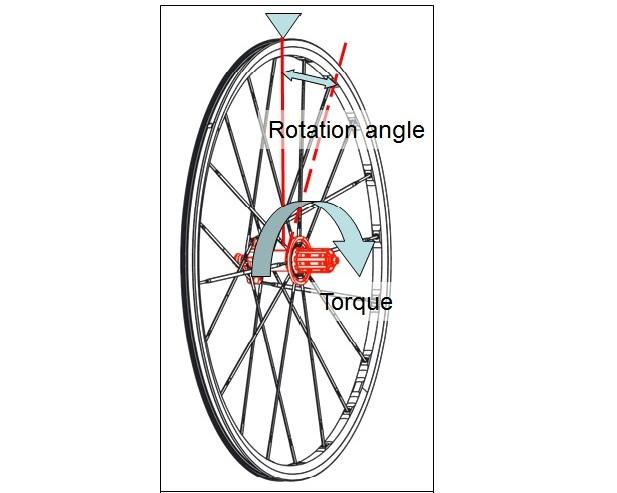
Radial stiffness is concerned with distortion of the wheel under a radial load – for example, a bump in the road:
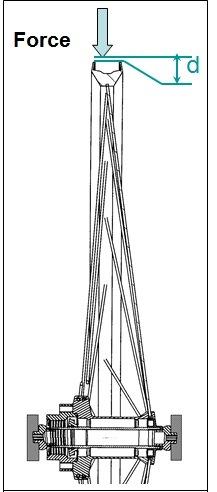
Lateral stiffness is all about side-to-side flex of the wheel from a lateral load – for example, when you climb and rock the bike left-to-right:

Those are the VERY basic explanations of the types of stiffness you want in a wheel. We’ll keep it at that, as I’d rather spend our time on practical implications, rather than science class.
Curse my Wimpy Wheels
If you’re new to the sport, I’ll attempt to translate what your riding buddies might be saying about wheel stiffness.
In general, nobody talks about torsional stiffness – simple as that. Torsional stiffness varies little between wheels, and the small differences aren’t generally perceptible by a rider. That’s what you need to know, and we won’t discuss it any further in this article.
If a rider is commenting on a wheel being “too stiff”, nine times out of ten they’re referring to radial stiffness. Mind you, may have their tires pumped up too much and be blaming the wheel for their mistake – but the point stands. If a wheel feels harsh, the scapegoat is almost always radial stiffness.
If a rider comments that a wheel isn’t stiff enough, nine times out of ten they’re talking about lateral stiffness. The wheel might rub their brake pads during a sprint, or generally feel ‘soft’ (which could very well be due to low radial stiffness or tire pressure). Again, regardless of actual cause – the scapegoat is ‘lateral stiffness’.
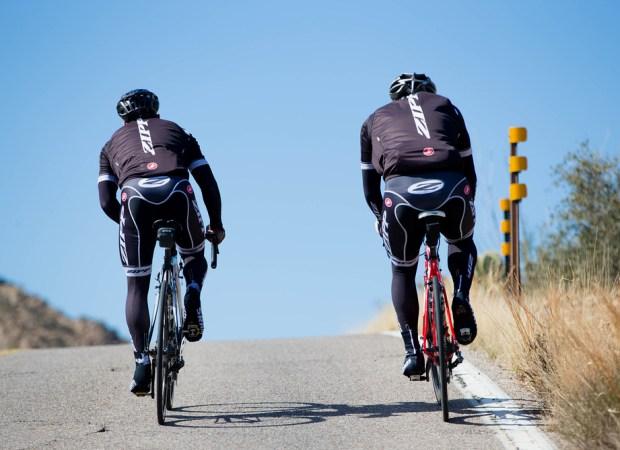
Above image © Eric Wynn
Are these riders really blaming the right thing? Are there aspects they might be overlooking? What else might be affecting the total stiffness of the system – in all three planes? Let’s throw out some ideas:
-Axle diameter and thickness
-Spoke count
-Number of spoke crossings
-Spoke thickness
-Spoke material
-Spoke type (j-bend or straight pull)
-Rim depth
-Rim width
-Rim material
-Fork leg stiffness and steerer tube diameter
-Chainstay and seatstay design
-Dropout alignment
See? What I’m really getting at is this: There is more than meets the eye. Calling a wheel “too stiff” or “not stiff enough” is an easy out.
Spoke Stiffness vs Rim Stiffness
There is a concept that I’d like to bring in to the discussion; one that almost nobody talks about. When we look at lateral stiffness, there are two distinct pieces of the puzzle – what I call ‘spoke stiffness’, and ‘rim stiffness’.
The stiffness provided by your spokes is determined by a few things. First and foremost, the number of spokes, and their thickness (or ‘gauge’). More spokes and thicker spokes make a wheel stiffer both laterally and radially. The Mavic graph below compares two different spokes to illustrate this – one of 1.8mm diameter, and one of 2.3mm diameter:
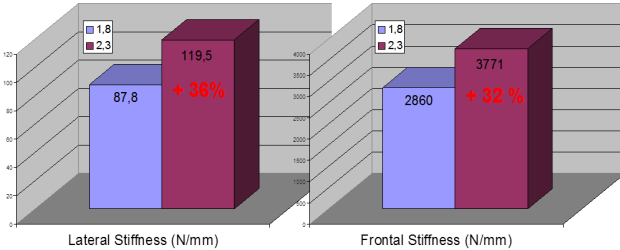
Spoke stiffness is also determined by the angle at which the spokes enter the rim. The main contributors to this are the rim depth and hub flange width:
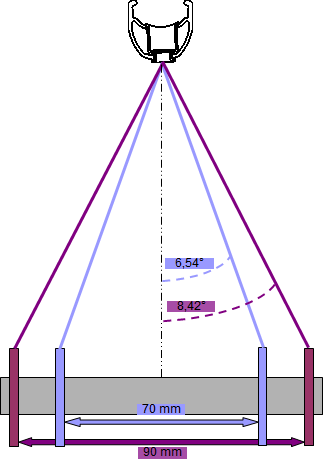
Wider flanges and deeper rims increase the spoke angle at the rim (assuming we’re talking about rims in which the spokes terminate at the rim ID). In simple geometric terms, the triangle created by the spokes and hub is wider – the base of the pyramid is more stable. This is the reason why 650c wheels are laterally stiffer than 700c wheels (assuming the same hub and rim construction). Got it?
Spoke angle is also affected by the height of the hub flanges:
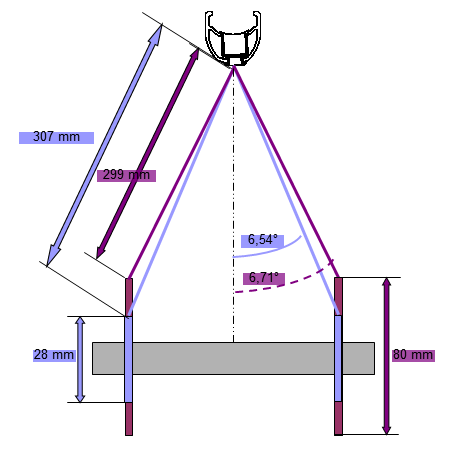
You may have heard a generalization that high flange hubs make stiffer wheels – always. “This wheel is totally stiffer than yours, dude… ‘cause my flanges are way higher!”
Please let me insert a screeching halt. Screeeeeeeech!
This is ONLY true if we’re talking about consistent flange spacing between the two different hubs. If your hub flanges are very tall – but not placed very wide, the resulting spoke angle is often worse than short, wide flanges. High flanges also carry a weight penalty – so they must be balanced with the total performance intent of the wheel.
The obvious limiting factor on rear wheel flange spacing is the cassette; this takes up a substantial amount of space on the drive side, and is a key limiter in rear wheel lateral stiffness. This is also the reason we often see flanges of unequal height on rear wheels (higher on the drive side) – some manufacturers are scraping for every last bit of spoke angle they can get.
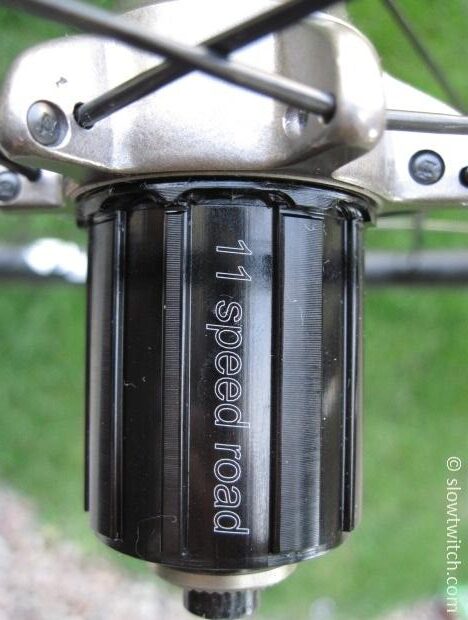
Last, spoke stiffness is determined – to a degree – by their tension. We’re not going to beat this one to death; as you can guess, loose spokes make for a flimsy wheel. Within a ‘normal’ range of spoke tension, wheel stiffness is unaffected.
Now that we’ve covered the concept of spoke stiffness, let’s move on to rim stiffness.
First and foremost – regardless of rim material – adding width or depth to a rim increases both the lateral and radial stiffness. According to Mavic, rim depth has a greater impact on radial stiffness, and rim width has a greater impact on lateral stiffness.

The reference rim is a shallow section Open Pro aluminum rim (18.4mm rim depth). The CXP30 is 30.5mm deep, and the MA3 is 16mm deep. As you can see, the CXP30 is the stiffest, both radially and laterally.
The next big determinant of rim stiffness is the material. For most bicycle wheels, we have two choices: aluminum and carbon. In general, carbon rims are both radially and laterally stiffer than aluminum. That statement is assuming a lot – so for now, understand that we’re only talking about carbon used in modern bicycle parts. By manipulating things such as thickness and modulus of carbon, it is possible to change some of its properties (again – that’s not for today’s discussion). Simply know that there is a very high probability that your carbon race wheels have stiffer rims than your aluminum training wheels.
The Discussion Gets Juicy
Consider everything leading up to this point an introduction. This is where the discussion gets really interesting.
When someone comments that their race wheel isn’t stiff enough, what they likely mean is this: Their wheel has too much lateral rim stiffness and not enough lateral spoke stiffness. That’s the big secret! You may feel compelled to say, “A-ha!”
How often do riders complain of their shallow-section aluminum wheels not being stiff enough? I don’t know about you, but I almost never hear that – short of a wheel with spokes that are far too loose. The reason you never hear that is because most aluminum wheels have relatively high spoke stiffness and relatively low rim stiffness. Think of wheel with 32 spokes of 2mm diameter, laced to a 20mm deep alloy rim – that’s a lot of spoke material and not much rim.
This graphic illustrates the concept beautifully:
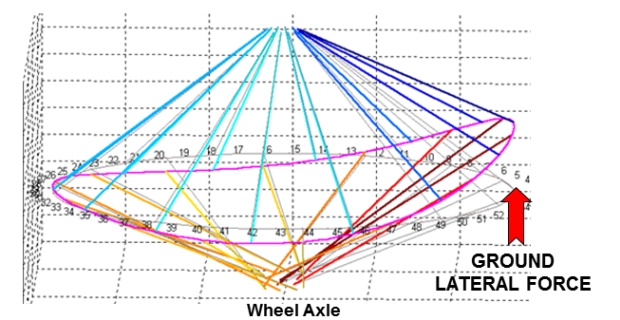
As you climb on an aluminum rim and rock the bike back and forth, the bottom half of the rim tends to follow the road. The rim bows to comply with your pedaling. The top half of the rim tends to stay relatively straight between the brake pads. If someone’s wheel does NOT rub their brakes, they often assume it’s because the wheel is stiff – or perhaps that the wheel and frame are both stiff. In reality, it’s likely that the rim is not very stiff, regardless of anything else.
When carbon rims enter the scene, it’s a whole ‘nother story. This wonderful graphic was provided by the folks at Zipp:
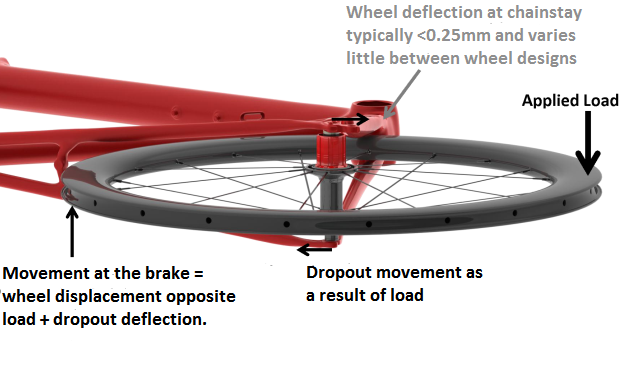
When you start climbing or sprinting on a carbon wheel, the stiff rim tends to want to stay perfectly straight – relative to itself.
This gets compounded by the fact that most “race” wheels have thin aerodynamic spokes – AND not very many of them. On top of that, in very recent years, we have also seen carbon rims grow in both width and depth – subsequently gaining both lateral and radial stiffness.
What this adds up to is the perfect wheel storm: An astoundingly stiff, deep-section carbon rim – strapped on to a handful of thin aero spokes. The stiff rim can literally overpower the spokes. If your rim rubs your rear brake pads, this is probably why.
To help illustrate, Zipp also provided the graphic below. The blue line is a 303 Firecrest tubular, the green line is a 404 Firecrest tubular, and the purple line is an 808 Firecrest tubular. All of them were built with 20 Sapim CX-Ray spokes.
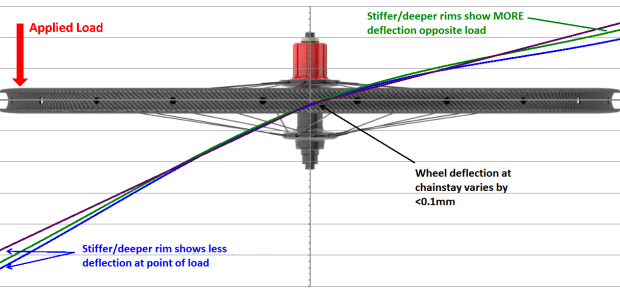
As you can see, the deeper and stiffer rims deflect less at the point of load (the road surface). However, they deflect more on the opposite side – where the brake caliper sits on a normal road frame.
Zipp says that for a given rim depth, adding rim stiffness reduces opposite-side deflection to a point, but adding stiffness beyond that increases opposite side deflection. They say that it is a balancing act, and stiffer is not always better when it comes to rims. They tune the stiffness of each rim depth and width, depending on the number of spokes used, to avoid opposite-side movement.
They also mentioned that the wheel’s movement in the dropouts acts as a multiplier of sorts, and is affected by the alignment of the dropouts themselves, and the stiffness of the bike’s chainstays and seatstays. If the frame is weak, the wheel will move more between the brake pads.
Regardless, adding more spokes or thicker spokes reduces both deflection at the point of load and deflection opposite of the load, on any brand of carbon wheel.
Brake Placement
What if your brake is at the bottom bracket, and not the seat stays? More and more modern triathlon bikes feature these low-mounted brakes.
For this discussion, we really need to split lateral stiffness in to two separate parts – horizontal and vertical:
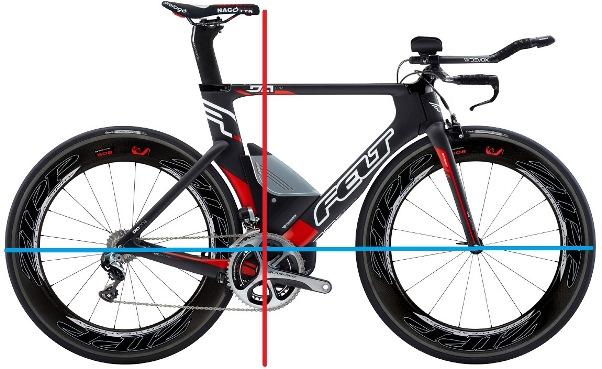
According to Zipp engineers, wheels don’t flex very much in the area of low-mounted TT brakes; this is more a function of frame stiffness. As you push on the pedals and flex the bottom bracket, they say that the frame wants to bend in this direction. You could think of it as the frame wanting to move around the wheel.
Practical Implications and Compromises
In the past, I did a lot of work with ProTour road teams, and this brake pad rub was a constant point of discussion. The mechanics would say, “The wheels are not stiff enough!” Sometimes they’d increase the spoke tension on all of the wheels to try to help. The real solution – and what you see done by many wheel manufacturers – is a custom spec wheel for the professional teams. You’ll see thicker spokes, higher spoke counts, and brass spoke nipples (which are more tolerant of high tension and poor conditions). They need to bring more spoke muscle to the fight.

What about you – the ‘average consumer’? If you’re in the fat of the bell curve – middle-of-the-pack age grouper, 5’2” to 5’10”, 110 to 175 lbs… you may very well be just fine on any off-the-shelf wheel.
I personally have never had an aluminum rim rub my brakes, but I have had issue with carbon rims. For reference, call me a ‘reasonably strong 170 lb athlete’. My old race bike was a carbon frame with low-mounted TT brake. My usual rear wheel was a stock deep-section carbon clincher with 20 thin aero spokes. While climbing very steep hills, the rim would rub the rear brake pads – which were shaved down – and the caliper was open as much as possible without the lever pulling to the bar. What to do? I exchanged the wheel for an identical one – except for the spoke count, which was 24. Interestingly, the brake rub went away. My suspicion is that the stiffness of both parts – the wheels and the frame – play together to make up a total system stiffness. Adding in a few spokes solved my problem.
Aren’t more spokes and thicker spokes heavier and less aerodynamic?
Yes, adding more spokes or thicker spokes adds weight and drag. That’s life. On the flip side, you’re losing power by flexing a wheel or rubbing the brake pads. I inquired with several different manufacturers about the aerodynamic cost of adding a few spokes (i.e. using 24 rear spokes instead of 20). All replied with the same answer: The aerodynamic cost is minimal. The weight penalty is minimal. You do gain a little bit of radial stiffness – which could be seen as ride harshness – but I argue that this is a non-issue, short of extreme cases.
Why, then, don’t they use more spokes? Two words – fashion and weight. Fewer spokes look cool, and look better on-paper to the gram counters. I agreed to keep any official comments off-the-record from all manufacturers in this regard… but all of them had similar answers – sex sells.
The Argument for Custom Builds
As product technology and cost-of-goods continue to increase, we continue to see fewer and fewer options being offered. More options mean more inventory and more complicated production – all of which are the enemies of low production cost.
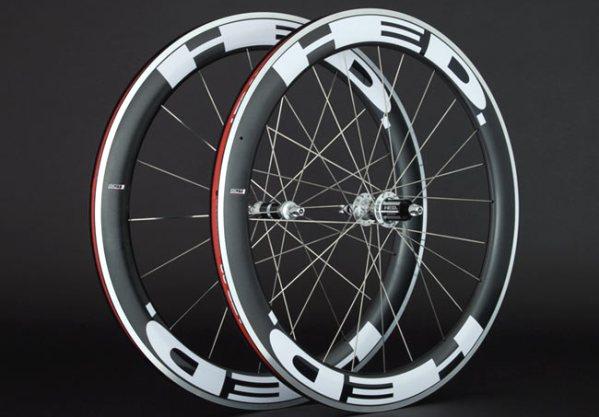
Hed continues to offer a higher-spoke-count option, called “Stallion”. Zipp had an option for this in the past, called “MAX”, but it has since been discontinued.
Mavic has taken a slightly different approach. After speaking at length with their staff, they place a high priority on the total performance of the wheel – aero, stiffness, weight, efficiency. For example, the deep bladed spokes on their Cosmic Carbone SL were chosen to retain stiffness that could not be provided by other super-narrow bladed spokes:
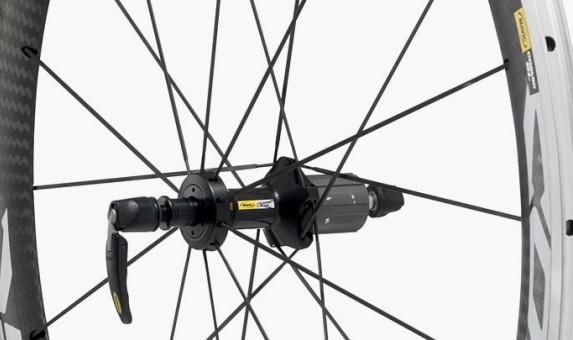
My impression is that they’ve aimed at a slightly heavier and/or more powerful portion of the bell curve of riders. Perhaps they're giving up a watt in aerodynamics, but gaining it back in stiffness and lack of brake rub. Mind you, I don't think that any single wheel is appropriate for ALL riders.
What is right for you? Unfortunately, I cannot answer that. There are too many factors and too much context to consider. I will say this – having built a lot of wheels and worked on a lot of bikes, I feel that the appropriate minimum number of spokes for most modern carbon wheels is 18 front and 24 rear (assuming we’re talking about the wildly popular Sapim CX-Ray and DT Aerolite – which are both quite thin and have nearly identical dimensions). In my experience, that covers most (but not all) riders.
If you want to go down to, say, 16 front spokes and 20 rear spokes, I argue that the CX-Ray and Aerolite are not appropriate for strong male riders. Perhaps some can get away with it, but it will depend on frame stiffness, fork stiffness, brake setup, dropout alignment, pedal-stroke-smoothness, and so on. If 16/20 is the magic number for aesthetics, something like the slightly-deeper Sapim CX (minus the ‘-Ray’) is a great choice.
Thankfully, a small handful of specialty custom builders still exist, such as Wheelbuilder.com. They offer a myriad of choices in both spoke count and spoke type – made to suit most any rider. If you find that the typical off-the-shelf carbon wheel doesn’t feel substantial enough, Wheelbuilder is a fantastic option.
What about disc wheels?
How do disc wheels fit in to this stiffness game? Discs are a unique beast. There are two main types – structural discs and wheel covers. Structural discs are those that do not contain any spokes; the skins of the disc are the wheel. Examples include the Mavic Comete, and all of Zipp’s discs.
Wheel-cover-type discs are any of those that are a spoked wheel underneath – with a cover placed on top. Examples include Hed’s Jet and Stinger discs, and the Wheelbuilder AeroJacket.
Wheel covers will tend to result in a disc that behaves more like a standard spoked wheel. Structural discs, however, tend to behave as though they have high rim stiffness AND high spoke stiffness (which is to say – they’re plain stiff). Zipp is unique in that they offer a special model – the Sub-9 – that offers improved comfort due to reduced radial and lateral stiffness.
We hope you’ve enjoyed this in-depth analysis of the ins and outs of wheel stiffness. With any luck, you may look at those latest-and-greatest race wheels with more of a critical eye. Are the spokes and rims balanced to each other? Are they built appropriately for both the 100 and 200 lb riders of the world? Does one size really fit all?
As always, we’d love to hear about your experiences in the comments.



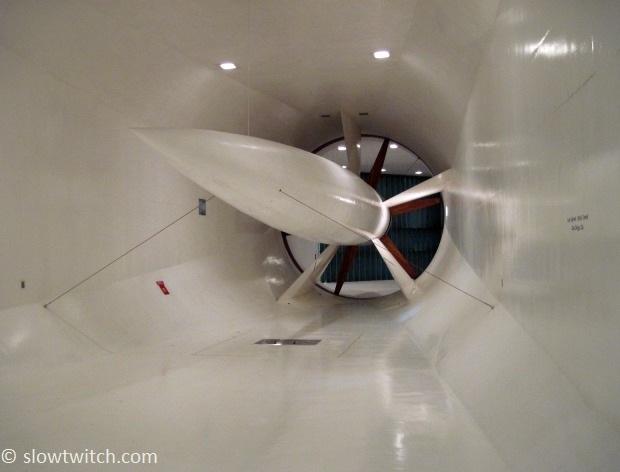
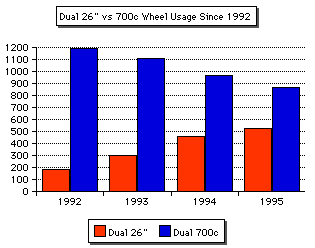
Start the discussion at slowtwitch.northend.network